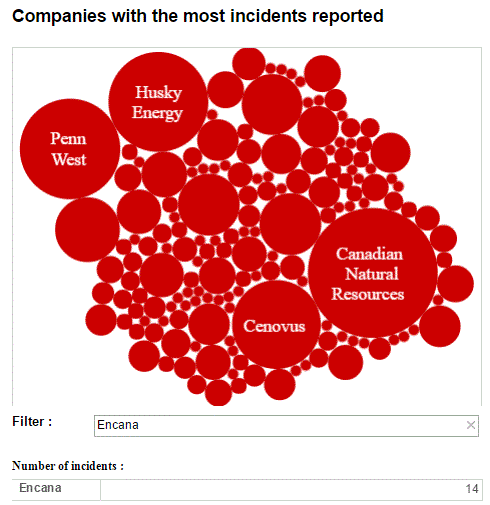Politicians, Pembina Institute and regulators more concerned with their failure to deceive the world about Alberta’s self-made polluting black-eye?
Oilpatch business icon and CEO CNRL Murray Edwards changes residency from Calgary to London by Dan Healing, March 24, 2016, Calgary Herald
Murray Edwards, one of Canada’s wealthiest people, has changed his residency from Calgary to London to avoid rising provincial and federal income taxes.
On Wednesday, Magellan Aerospace Corp., a Mississauga, Ont., aircraft manufacturer in which Edwards holds 74 per cent of the shares and acts as chairman, listed his residence as “London, United Kingdom,” in its annual information form filed with regulators Wednesday.
Two sources familiar with the situation who asked not to be identified said Edwards is switching his residency to the U.K. for income tax reasons.
Taxes for high-income earners in Alberta increased dramatically over the past year with the top federal/provincial combined marginal rate rising from 40.25 per cent in 2015 to 48 per cent in 2016. [How much greedier and low can a human get? Running from an 8% increase when so many children in Canada are starving and so many families across the country (not just First Nations) do not have access to safe potable water?]
In order to be considered a non-resident by Canada for tax purposes, a person must routinely live in another country or show they don’t have significant residential ties to Canada by staying in the country for fewer than 183 days a year.
The finance and oil and gas magnate, who is also a part owner of the Calgary Flames and owns ski resorts through Resorts of the Canadian Rockies, didn’t immediately return a phone call or email asking for comment on Thursday.
The Magellan information contradicts the annual information form filed by Calgary-based Ensign Energy Services Inc. last week, in which Edwards’ residence is described as Calgary/Banff, as it has been for several years. He is also chairman of Ensign and holds about 16 per cent of the shares.
Edwards is the executive chairman of Calgary-based Canadian Natural Resources Ltd., Canada’s largest producer of heavy oil. That company hasn’t filed its regulatory forms yet but the ones filed in March 2015 show his address as Calgary/Banff.
Edwards was listed as the second-richest Calgarian on the Forbes list of billionaires released this month with a fortune pegged at $1.33 billion, a fall from last year’s valuation of $1.8 billion due mostly to the decline in the price of oil and the value of the shares he owns. [Emphasis added]
Steam Injection Fractures Caprock in Big Alberta Spill, Regulator Confirms, Incident highlights fragility of high-cost energy extraction by Andrew Nikiforuk, March 23, 2016, TheTyee.ca
Three years after an eruption of 10,000 barrels of melted bitumen contaminated the boreal forest and groundwater near Cold Lake, Alberta, the provincial energy regulator has now officially blamed hydraulic fracturing, or the pressurized injection of steam into the ground for fracturing nearby rock.
The bitumen blowout occurred sometime between May and June 2013 at Canadian Natural Resources Ltd.’s Cold Lake project, an operation that uses steam injection to melt bitumen and bring it to the surface.
In this case, the pressure from the steam cracked rock between different formations, allowing melted bitumen to find natural fractures and flow to the surface at five different locations, including under a lake.
In some places, the bitumen erupted through fissures in the ground as long as 159 metres deep.
The event, not the first of its kind as an earlier Tyee investigation revealed, killed wildlife and seeped nearly 20 barrels of bitumen a day into muskeg over a five-month period.
In a lengthy report, the Alberta Energy Regulator concluded what experts had suggested all along — that all five bitumen seeping events “were caused by excessive steam volumes, along with an open conduit (wellbore or natural fracture or fault) or hydraulically induced vertical fractures.”
According to the regulator, an independent third party expert panelthat also reviewed the bitumen disaster found that the company, a major bitumen producer, had failed to properly account for geological faults and fractures in the region it was steaming.
That panel submitted “that CNRL’s approach had insufficiently addressed the impact of geological variability” and how natural fractures would respond to increases in steam pressures.
In particular, the company did not properly address a new geohazard in the tarsands: the erosion of salt formations underneath bitumen deposits by the movement of groundwater.
The industry-funded regulator concluded that “CNRL did not contravene any rules in their use of their specific steaming strategy,” but has since implemented regulatory requirements “designed to prevent a further incident and permanently reduce steaming volumes.”
Fragile, inefficient operations
The incident, which cost Canadian Natural Resources Ltd. nearly $50 million to clean up, highlights the fragility of operations that fracture bitumen formations with high-pressure steam.
These energy-intensive projects, which often use more than three barrels of steam to produce one barrel of bitumen, now produce the majority of Canada’s bitumen for export. At current oil prices, such inefficient operations are losing money.
Approximately 80 per cent of Alberta’s bitumen deposits lie deeper than 75 metres and cannot be mined. The majority of bitumen extraction now comes from steaming operations that use gravity or waves of steam to melt a resource as hard as a hockey puck.
As a consequence, the deep deposits, all capped by rock, are currently being heated to as high as 300 C with steam.
During the steaming process, the overlaying caprock acts as a primary but not always impermeable seal that keeps steamed bitumen from seeping into aquifers, industry wellbores and other geological formations, as well as the forest floor and lakes.
For years, geoscientists as well as annual industry progress reports to the Alberta Energy Regulator consistently showed that the technologies used to steam deep deposits have created the same sort of problems now plaguing the hydraulic fracturing of unconventional oil and gas resources across North America.
Both technologies inject highly pressurized fluids (gas, water, steam or hydrocarbons) into formations, where the resulting pressure can crack or fracture overlying rock and well casings in unpredictable ways. These fractures can bring fluids or gases to the surface, contaminate groundwater or connect with other existing wells.
Across North America, hydraulic fracturing has triggered earthquakes, pushed gases to the surface, connected to natural faults and fractures, “communicated” with other wells, damaged nearby wellbores and contaminated groundwater.
The ongoing problem for industry is that it can’t control where the fractures will go or what natural faults they might connect with.
In Canada’s heavy oil production, the injection of steam has amassed a long case history of problems, including fracturing into well sites and other formations, steam leaks and blowouts. Fracking bitumen with steam has also mobilized arsenic and fouled groundwater.
Still waiting on caprock study
The large Canadian Natural Resources Ltd. bitumen spill occurred exactly at the same place where another major leak occurred in 2009. The regulator did not report on that event until years later.
The new regulator report confirmed that caprock “is being compromised during high pressure cyclic steam stimulation” at CNRL’s Primrose East project.
Injection pressures and steam volumes used by CNRL “either activated existing fracturing and faulting” of caprock or “altered the stress state enough to induce fracturing to enable releases of bitumen emulsion into the Grand Rapids Formation.”
The bitumen then migrated up through natural fractures, faults, or vertical hydraulically induced fractures to the surface.
Cyclic steam injection, which pumps steam into a single well for weeks at a time allowing the steam to soak and build up pressure underground, has been plagued with technical problems for years.
In 2002, petroleum geologist Maurice Dusseault reported that steam injection due to high pressures caused “hydraulic fracturing out of zone, perhaps intersection with ‘thief zones’ and the opening of fracture pathways to water or the surface.”
To deal with these major geohazards and the threat to caprock, the Energy Resources Conservation Board (now the Alberta Energy Regulator) created a special Oilsands Caprock Integrity Project seven years ago.
At the time, OCRIP’s website specifically warned that “uncontrolled releases of steam, oil or formation water caused by in situ oil production (e.g. cyclic steam stimulation and steam-assisted gravity drainage) create concerns for resource and environmental conservation.”
But OCRIP has yet to publicly release a promised analysis of “human-induced geological hazards” in the region, as well as an incident review database of steam operations that have broken the caprock. The project’s website appears to no longer exist.
A 2011 paper written by employees of Schlumberger, an oil servicing multinational and fracking expert, warned that continuous steam injection can deform a bitumen formation so badly that it can “reduce rock strength, induce new fractures or re-activate existing fractures posing contained risk of containment of breach of caprock.”
In turn, the fracturing of caprock “can provide pathways for bitumen and steam to flow to aquifers or to the surface causing significant risk to safety and the environment,” warned the paper.
Cold Lake bitumen leaks offer lessons for all by Chris Varcoe, March 22, 2016, Calgary Herald
After one of its most complex investigations ever, the Alberta Energy Regulator finally delivered its report into the problems behind a series of bitumen emulsion leaks at Canadian Natural Resources’ Primrose oilsands project in 2013.
There should be no cause for celebration.
The regulator said Monday that the high-profile leaks were caused by excessive steaming at the underground oilsands project, combined with an open conduit — such as old well bores, natural faults and man-made, hydraulically induced fractures — that allowed the mixture to seep to the surface.
The unique geology of the area on the Cold Lake Air Weapons Range may have also contributed to the so-called “flow-to-surface” (FTS) event, where 6,600 barrels of emulsion leaked, it said.
“Since the exact pathways for the FTS events were not definitively determined, sufficient controls need to be applied to account for all the different possible pathways,” the report concluded.
There were four releases of the watery bitumen emulsion at the Primrose site in May and June 2013, following an earlier 2009 episode.
Canadian Natural previously stated an old well bore contributed to each event, although the AER now believes it likely only contributed to one case.
The regulator noted Monday that the company didn’t contravene any rules, as it was complying with existing operating limits with its high-pressure cyclic steam stimulation used to extract the molasses-like crude.
The problems at Primrose, however, drew national attention.
Images circulated of black oily bitumen coating the muskeg in northern Alberta. It was the last thing needed by an industry and province struggling to defend its reputation from outside attacks.
It also raised questions about the effectiveness of the province’s environmental oversight and the role of Alberta’s regulator, something both institutions face to this day. [“No Duty of Care”]
“We certainly don’t want to see incidents like this ever. They are certainly not acceptable,” Alberta Energy Minister Marg McCuaig-Boyd said Monday. [Is it acceptable for the AER to deregulate and allow oil and gas companies to frac thousands of energy wells above the Base of Groundwater Protection?]
Canadian Natural Resources spokesperson Julie Woo said the company has since made changes at the project, including modifying steaming strategies, improving pressure monitoring and dealing with existing well bores.
Likewise, the AER says it’s made key changes. It imposed restrictions to reduce the likelihood of further problems, including limiting steam injection volumes at Primrose.
The AER’s examination is now, finally, closed. [Until the next CNRL greed induced spew]
Technical issues surrounding the leak will undoubtedly be studied and dissected in the months and years to come by other companies, environmental groups and the government.
The incident will have ramifications for all sides.
The report comes as a broader discussion has broken out in the country about energy development and the proper role of independent agencies overseeing it. [WHERE IN NORTH AMERICA IS THERE AN INDEPENDENT ENERGY OR WATER REGULATOR?]
A poll by Ekos Research Associates for CBC this month underscores the concerns.
It found only 43 per cent of Canadians say they have confidence in the National Energy Board, which reviews major projects such as LNG terminals or cross-border pipelines, while 50 per cent say they have little or no confidence in the regulator.
Pollster Frank Graves with Ekos noted 79 per cent of Canadians agree with the statement that there needs to be stricter laws and regulations to protect the environment.
Yet, 55 per cent of people said they’re more worried about economic issues than environmental issues. And 92 per cent of respondents think the oil and gas industry is important to Canada’s economy.
“There are contradictions in the public about the economy and energy and what we do about the environment,” Graves explained.
“Regulators are confronted and are right in the middle of these debates. We are deeply conflicted. And I think the answer is the public is saying we need to do both.”
Chris Severson-Baker of the Pembina Institute points out the AER is taking more active oversight in these issues compared with its predecessor, the Energy Resources Conservation Board. [By deregulating and blanket approval, one size fits all NALA frac frenzy intended to spread across Alberta? A no duty of care regulator, legally immune even for gross negligence, acts in bad faith and Charter violations? What is Pembina Institute smoking?]
The long list of regulatory requirements for Canadian Natural Resource’s in situ project didn’t exist before these problems unfolded three years ago.
“I think the regulator has learned a lesson here, that it needs to have more operational control over these types of projects,” he said. [By deregulating and making it now legal to frac drinking water supplies and divert fresh water without a permit from frac’d shallow energy wells?]
Control is one thing. Explaining to the public what happened is another.
Bob Curran, the AER’s director of public affairs, said the organization is trying to be more transparent and provide [propaganda] information the public can examine, from its YouTube channel and Twitter account to data posted on its website.
He believes there’s been a shift in public expectations and “that thirst for information out there is unquenchable.” [Thirst or response to the endless lies by AER publicly claiming all chemicals used in fracking are disclosed, one only has to ask, but not providing the information when asked? When is AER rolling out free public access to complete chemical disclosure for all products used in the oil and gas industry, including in drilling, cementing and servicing?]
“It’s important to be a [“No Duty of Care,” enabling, pollution cover-upper, lying, bullying harmed citizens, law-violating, Charter-violating, acting in bad faith & gross negligence] regulator that Albertans are confident in,” Curran said.
But earning confidence takes time and a commitment by all sides. Only by avoiding future problems — above or below ground — can trust fully be restored. [Emphasis added]
Excessive steaming a factor in CNRL’s Primrose leaks: Alberta regulator by Lauren Krugel, The Canadian Press, March 20, 2016, Calgary Herald
Excessive steaming was one of the factors that caused more than a million litres of oily water to ooze to the surface at an eastern Alberta oilsands site nearly three years ago, an investigation by the Alberta Energy Regulator has concluded.
The AER’s report, released Monday, also said the bitumen-water emulsion was able to travel from deep underground through old unused wellbores, natural fractures and faults as well as man-made cracks in the rock.
“This is one of the most complex investigations we’ve ever undertaken,” said Kirk Bailey, executive vice-president of operations at the provincial energy watchdog.
A separate investigation into a 2009 leak at the same site came to a similar conclusion.
Canadian Natural Resources Ltd. (TSX:CNQ) had been using an extraction method at its Primrose oilsands property called high-pressure cyclic steam stimulation…. That technique involves injecting steam deep into a reservoir through a well, letting it soak so that the thick bitumen is liquefied, and drawing the oil up to the surface through the same well.
Pressure restrictions imposed at Primrose following the leaks discovered in May and June of 2013 have been made permanent to avoid a similar event from happening in future.
“The company will not be able to pursue its original operating strategy at Primrose,” said Bailey.
Cyclic steaming is widely used in the oilsands. Bailey said the AER took a broader look at other operations and concluded that they are safe. [What does AER conclude about Encana’s illegal fracing of drinking water aquifers, contaminating water wells with natural gas and blowing up a drinking water reservoir? Terrorist activity?]
The geology at Primrose is particularly complicated because a layer of salt underlies the bitumen reservoir, said Bailey. As the salt has partially dissolved, rock formations closer to the surface have been weakened.
The AER said CNRL didn’t break any rules with its steaming technique.
Both the company and the regulator say the amount of bitumen that can ultimately be recovered at Primrose is unchanged. But the AER said it may just take longer to do so.
The AER’s final report on Primrose follows probes by the company and by an independent technical panel.
The AER didn’t agree with CNRL’s view on how big a role the wellbores played.
“I think the company’s point of view is that they played a larger role,” said Bailey.
As a result, the restrictions the AER is imposing are “more conservative” than they would have been if the wellbores were the main factor.
CNRL spokeswoman Julie Woo said the company produced 4,000 pages of technical data and interpretation in its investigations. [Where are the 4,000 pages of technical data on Encana fracturing hundreds of gas wells into the fresh water zones at Rosebud?]
“As a result of extensive data gathering, investigation, analytical analysis and interpretation, Canadian Natural and the industry’s understanding of cyclic steam processes has been enhanced. These learnings have been applied and our operational practices and strategies have been modified to mitigate the risk of future seepages,” she said in an emailed statement.
“Our enhanced operational practices and strategies — in place since July 2013 — includes modified steaming strategies, enhanced pressure monitoring and response strategies as well as remediation of wellbores to mitigate the risk of future seepages.” [Emphasis added]
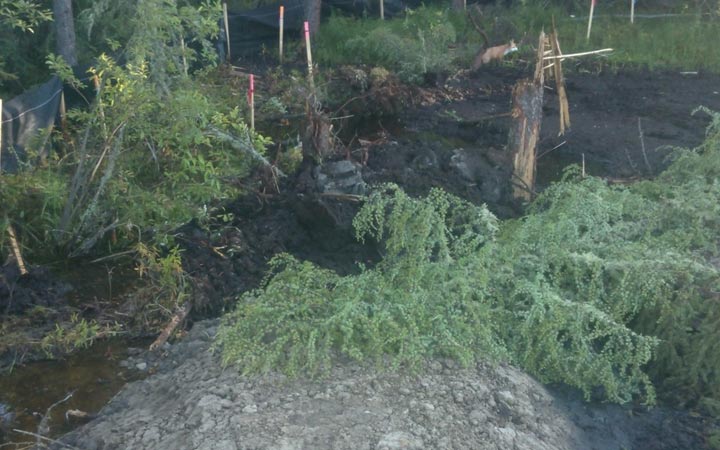

Excessive steaming a factor in CNRL’s Primrose leaks: Alberta regulator by The Canadian Press, March 20, 2016, Calgary Herald
CALGARY – The Alberta Energy Regulator says excessive steaming was one of the reasons behind high-profile leaks at Canadian Natural Resources Ltd.’s Primrose oilsands project nearly three years ago.
The watchdog’s final report on the incident cites the ability of the bitumen-water mixture to make its way to the surface through old well bores and natural and man-made fractures in the rock.
CNRL had been using an extraction technique at the eastern Alberta project called high-pressure cyclic steam stimulation, the safety of which has been questioned by environmental groups.
AER executive vice-president Kirk Bailey says the technology has a good track record elsewhere in the province and there are currently no concerns about its use by other operators.
The AER says CNRL didn’t break any rules with its steaming technique, but the regulator has ordered the company to permanently reduce it’s steaming volumes at the site to make sure a similar incident doesn’t happen again.
The pressure restrictions may affect the pace at which CNRL is able to produce bitumen at Primrose. [Emphasis added]
CNRL Primrose incident caused by excessive steaming; AER releases final investigation report Press Release by AER, March 21, 2016
Following a thorough investigation, the Alberta Energy Regulator (AER) is implementing additional requirements at Canadian Natural Resource Limited’s (CNRL’s) Primrose operations on the Cold Lake Air Weapons Range.
“This is one of the most complex investigations the AER has undertaken, and although we would normally just release the results on our compliance dashboard, we felt it important that Albertans were fully informed about the work that went into this unique investigation as well as its outcome,” says Jim Ellis, AER President and CEO.
The new requirements are as a result of four flow-to-surface events, which started in May 2013 at CNRL’s Primrose South and East locations, which resulted in the release of 1057 m3 of bitumen emulsion. CNRL also reported a flow-to-surface event in 2009.
In its investigation report, the AER concludes that the flow-to-surface events were caused by excessive steam volumes, along with open conduits such as well bores, natural fractures and faults, and hydraulically induced fractures.
The investigation report considered the information and findings provided by CNRL in its final report, as well as the results of an independent technical review panel. The report also describes all possible contributing factors, including the unique geology of the area, which may have contributed to the flow-to-surface events.
CNRL did not contravene any rules in their use of their specific steaming strategy, however the AER has since imposed regulatory requirements designed to prevent a further incident and permanently reduce steaming volumes. Should the company fail to meet these requirements, they could face enforcement action.
The Alberta Energy Regulator ensures [big profits for multinationals and looking the other way instead of enforcing laws and regulations, cover-up for law violations and aquifer fracing and contamation, Charter violations and bullying of harmed citizens. AER is 100% funded by industry with no mandate to protect public health or the public interest.]
Backgrounder: Timeline of events
– See more at: http://aer.ca/about-aer/media-centre/news-releases/news-release-2016-03-21#sthash.RlUBHJLr.dpuf
FOR BROADCAST USE
The Alberta Energy Regulator has released its final investigation report in the 2013 CNRL incident that caused four flow-to-surface events near Cold Lake. The AER believes that the incidents were caused by excessive steaming by CNRL and, as a result, has put additional restrictions on operations in the area.
– 30 –
For more information, please contact:
Bob Curran, AER Public Affairs
Phone: 403-297-3392
E-mail: email hidden; JavaScript is required
Media line: 1-855-474-6356
NR-2016-02
How to reward CNRL’s greedy, land and water polluting behaviour, AER deregulates. Shame on syngerizing Pembina Institute:
Pilot project allows Canadian Natural to put 47 wells in one application by Dan Healing, March 18, 2016, Calgary Herald
Canadian Natural Resources Ltd., Canada’s largest heavy oil producer, has applied for regulatory approval for 47 wells in northeastern Alberta under a red-tape-cutting pilot program that allows producers to lump multiple activities into one set of paperwork.
The single application posted on the Alberta Energy Regulator’s website this week requests permission to construct, drill, complete and operate 47 heavy oil wells on six multi-well pads and one single-well pad. It also seeks approval to build seven bitumen batteries, access roads and associated gas pipelines for fuel use and transport of associated gas.
The company said all the assets, located about 42 kilometres northwest of Cold Lake, will be managed singularly and construction of later projects may depend on the success of early ones, thus requiring an extended approval term of five years.
Heather Sampson, regulatory co-ordinator for Canadian Natural, said in a letter attached to the application that the single application process launched last year will “improve the effectiveness and efficiency” of stakeholder consultations.
“Combining individual developments in an area enables Canadian Natural and area stakeholders to consider potential development plans for the region over the next five years, which provides the ‘bigger picture’, and a more effective and fulsome consultation,” she wrote.
The news comes as the AER is scheduled to release results of an investigation on Monday into four flow-to-surface bitumen leaks in the spring of 2013 from Canadian Natural’s Primrose thermal oilsands project in the nearby Cold Lake Weapons Range.
The incident resulted in steaming restrictions and $40 million in cleanup costs for the company, which blamed a faulty oil well drilled by another operator. Even after the company stopped steaming, bitumen emulsion continued to seep up in four separate locations across the company’s acreage for months.
The newly applied-for well pads are about 13 kilometres southwest of Primrose.
There, bitumen would be produced using a common production technique called CHOPS or cold heavy oil production with sand, where the unheated product is pumped to a surface storage tank and then trucked to an oil battery for processing.
AER spokeswoman Carrie Rosa said Friday the application is actually the second under the new program. Suncor Energy Inc. applied last fall under the pilot for an amendment to the previous approval of its proposed Meadow Creek East thermal oilsands project about 45 kilometres south of Fort McMurray.
“Starting with a few projects, the AER is accepting a single application for multiple activities related to a project,” she said.
“Currently, the AER looks at applications as single discreet items, even though many applications are for the same project or development. This will allow Albertans, and the AER, to consider the combined environmental impacts of multiple activities associated with a project in one application, which will enhance environmental management.” [Truth Translation: Deregulated Fracking Free for All]
Rosa said the results of the pilot will be used to improve the approach before it is implemented across the province.
The Alberta regulator conducted a play-based pilot project in the Duvernay shale play near Fox Creek which wrapped up last June 30. Rosa said the Canadian Natural application is under a similar but separate program.
Duncan Kenyon, program director of unconventional oil and gas for the environmental Pembina Institute, was surprised to hear about the new program and said the AER should have issued a public report on pluses and minuses of the earlier pilot before replicating it in other areas of the province.
He conceded that the single application approach has positives, such as avoiding duplication and allowing a better view of cumulative affects, but said it will still result in a massive deluge of paperwork for stakeholders to review.
Kenyon added the larger scope of project covered by the single application should result in the company listening to “a broader range of stakeholders,” both by geographic area and type, rather than restricting interveners to strictly those covered by current regulation.
Alberta Party Leader Greg Clark said he supports the concept of regulatory adaptation given the pricing pressure Alberta producers are under.
Canadian Natural spokeswoman Julie Woo said Canadian Natural has not established a budget or production profile for the series of projects.
The company said in its application there are no residences within half a kilometre of the muskeg-prone area it proposes to develop, part of which is within the Wolf Lake Provincial Grazing Reserve.
It said as part of provincial consultation requirements, it had provided information to the Beaver Lake Cree Nation, Cold Lake First Nation, Heart Lake First Nation, Kehewin Cree Nation and Whitefish Lake Indian Reserve. None had objections or concerns.
It vowed to keep stakeholders informed with annual mailed project updates. [Emphasis added]
Comment by Diana Daunheimer
Pom poms for play based regulations and lies about Primrose, how is this considered journalism?
The AER announced play based regulations, now referred to as NALA, for all of Alberta in their annual report published in August of 2015.
CNRL had to long ago admit that over pressured steaming operations damaged cap rock integrity creating numerous fissures in the Primrose play and could not lay blame on another operator or particular well site.
Folks, you are being fed pure shiz by the Calgary Herald, Mr. Healing and the Pembina Institute.
https://www.cnrl.com/…/initial-causation-review-report.pdf
http://www1.aer.ca/…/downloads/AER-Annual-Report-2015.pdf
Calgary oil and gas companies linked to almost 30% of incidents reported to Alberta Energy Regulator Take a look at the breakdown of more than 1,000 incidents from June 2013 by Samuel Danzon-Chambaud, February 25, 2016, CBC News
Calgary-based oil companies Canadian Natural Resources Limited (CNRL), Penn West Exploration and Husky Energy account for close to 30 per cent of incidents publicly reported to the Alberta Energy Regulator, according to a Radio-Canada analysis.
More than 1,000 incidents, ranging from June 2013 to now, are listed on the AER database.
It includes reportable incidents like releases of hydrogen sulphide and hydrocarbons, or instances of contaminating bodies of water. [Any report by Encana of the company illegally fracturing Rosebud’s drinking water aquifers?]
CNRL accounted for 137 reported incidents as of last Friday, Penn West for 82 and Husky Energy for 81.
Some energy giants didn’t appear as often in these statistics. Imperial Oil accounted for 14 incidents while Suncor Energy was responsible for five.
Most incidents were related to pipelines. They include minor incidents, but also more serious ones such as Nexen’s five million litre spill in July near Fort McMurray and the one million litre leak around CNRL’s Primrose site in 2013.
Gaétan Caron, a fellow at the School of Public Policy at the University of Calgary, said that company size may be linked to the number of incidents but other factors may also be in play.
“A company … with little culture of safety, or that is less conscious of the environmental impact of their operations, is more likely to appear in such a database,” said Caron. [Really?]
Greenpeace, companies react
Mike Hudema, a climate and energy campaigner at Greenpeace, said companies appearing repeatedly in the database should be punished.
“The government really should be putting a stop to their operations if they are not able to operate them safely,” said Hudema.
“It’s just a matter of time before we have a major disaster … we are putting the environment at risk, we are putting the communities at risk.” [It’s already happened, often]
Canadian Natural Resources spokeswoman Julia Woo said the vast majority of incidents mentioned in the database were of very low consequence, with no long-term effects to the environment. [Isn’t that what oil companies and their enabling Protti-led AER always say?]
“Our goal is to have zero incidents,” said Woo. “When rare [???] events occur, such as equipment malfunction that results in an incident, we have safety and environmental management systems in place to quickly manage these events.” [Like AER stop light system that rapidly escalated frac quake magnitude at Fox Creek?]
In a statement Husky Energy said that it takes all incidents seriously and responds appropriately. Penn West declined the opportunity to comment.
According to another database, Penn West has been issued seven suspension notices since July 2014, CNRL has received five and three have been issued to Husky Energy. [Emphasis added]
A few of the comments:
Grey Wolf
CNRL practice is entirely unethical. All they care is money and no regard to science or engineering. A major investigation of misconduct by CNRL management has been underway by APEGA since last year. More info: contact APEGA investigation department.Case #15-08
seeker444
From our actual negative experiences as landowners in rural southern Alberta, with the oil and gas industry, we know that they think in many instances that they think can operate with impunity, they have been and they’re used to it, and think nothing of it and with glaringly, not strong enough regulations.
Arrogance + + +…..Not surprised……..
An example, which is significant, is the Jessica Ernst $33 million lawsuit against Encana, Alberta Environment and the then regulator the ERCB, for water well contamination in the Rosebud , AB area from shallow fracking. She has even had a dog thrown under a train which was felt to be backlash. We hope she wins her case, which could impact the practice of fracking across North America.
Other Alberta rural folks who have taken legal action against the industry for damages from blown out sour gas wells, for example, have been threatened by ramming by industry trucks on their local gravel road and have had to put their paper work in several ‘places.’ Down and dirty………
Grey Wolf
These are the incidents that are reported and admitted by the companies. There are numerous instances of contamination observations that are either never reported or misinterpreted as a result of other irrelevant factors. In the case of CNRL, every year they report numerous cases of incidents as casing failures but in reality they are the observations of oil in overburden directly linked to the hydraulic fracture from the reservoir in they high pressure CS operation. In many other cases, they simply not report. Evidences of such negligence by CNRL and AER is currently being investigated by APEGA
[Refer also to:
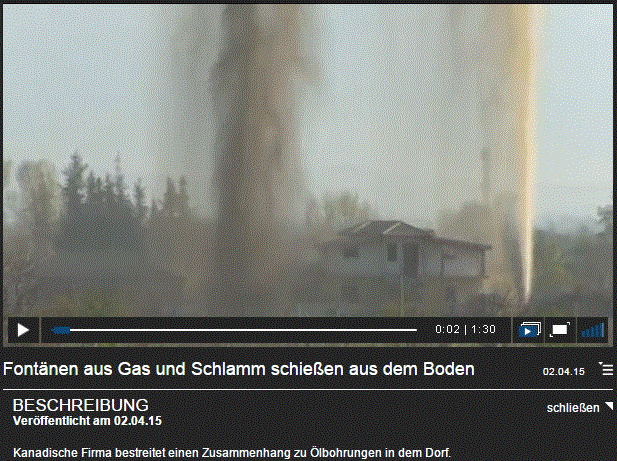
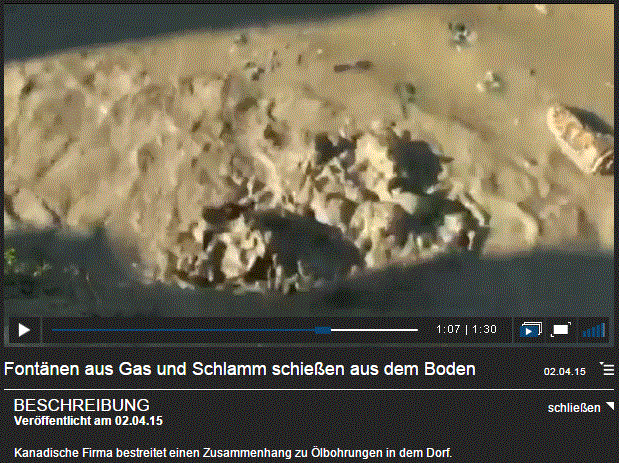
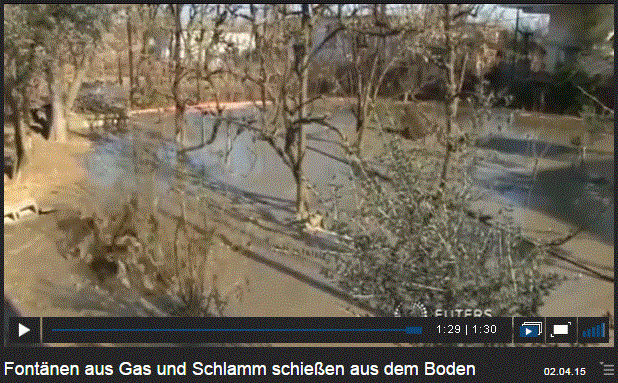
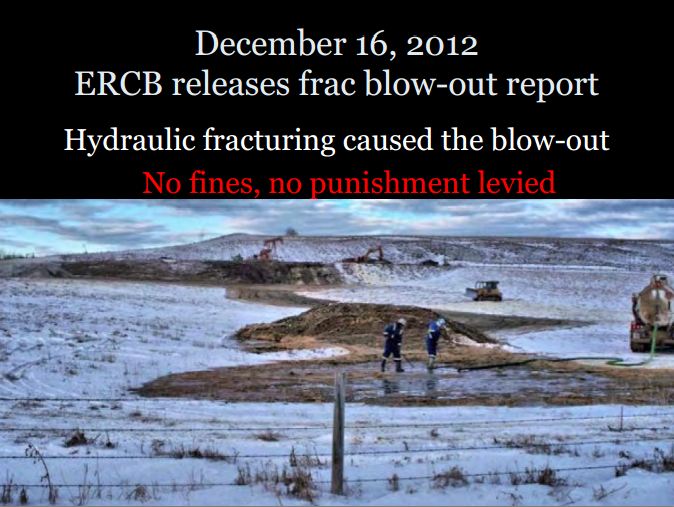
Slide from Ernst Presentation
How High does Bullshit Fly in Alberta’s Oil Patch and AER? Caprock Frac’er CNRL, Cry Baby or Bully?
Alberta regulator investigates another CNRL well leak in troubled leaking Primrose field
CNRL Cold Lake Bitumen Geyser Continues, Despite Company Claims ]

